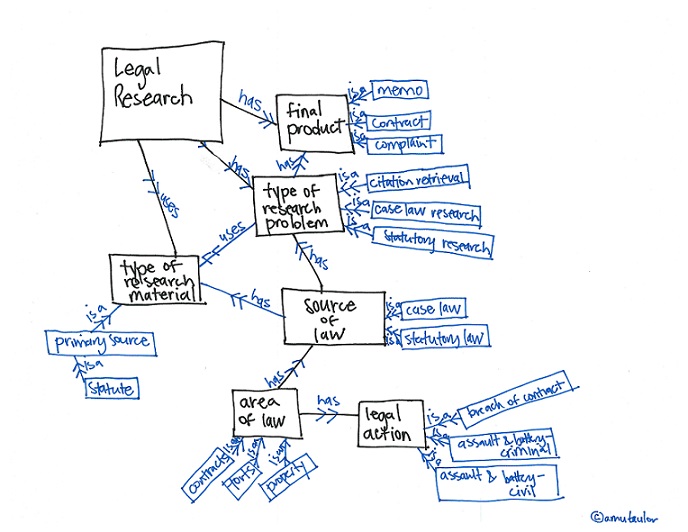VoxPopuLII
My blog post last year about developing a legal research ontology was such an optimistic (i.e., naive), linear narrative. This was one of my final notes:
At this point, I am in the beginning stages of taking advantage of all the semantic web has to offer. The ontology’s classes now have subclasses. I am building the relationships between the classes and subclasses and using Protege to bring them all together.
I should have known better.
What I didn’t realize then was that I really didn’t understand anything about the semantic web. While I could use the term in a sentence and reference RDF and OWL and Protege, once you scratched the surface I was lost. Based on Sara Frug’s recommendation during a presentation at CALI Con 2014, I started reading Semantic Web for Dummies.
It has been, and continues to be, slow going. I don’t have a computer science or coding background, and so much of my project feels like trying to teach myself a new language without immersion or much of a guide. But the process of this project has become just as interesting to me as the end product. How are we equipped to teach ourselves anything? At a certain point, you just have to jump in and do something, anything, to get the project moving.
I had already identified the classes:
* Type of research material;
* Type of research problem;
* Source of law;
* Area of law;
* Legal action; and
* Final product.
I knew that each class has subclasses. Yet in my readings, as I learned how ontologies are used for constructing relationships between entities, I missed the part where I had to construct relationships between the entities. They didn’t just magically appear when you enter the terms into Protege.
I’m using Web Protege, an open-source product developed by the Stanford Center for Biomedical Informatics Research, using the OWL ontology language.
Ontology engineering is a hot topic these days, and there is a growing body of papers, tutorials, and presentations on OWL and ontology engineering. That’s also part of the problem: There’s a little too much out there. I knew that anything I would do with my ontology would happen in Protege, so I decided to start there with the extensive user documentation and user support. Their user guide takes you through setting up your first ontology with step-by-step illustrations and a few short videos. I also discovered a tutorial on the web titled Pizzas in 10 minutes.
Following the tutorial, you construct a basic ontology of pizza using different toppings and sauces. While it took me longer than 10 minutes to complete, it did give me enough familiarity with constructing relationships to take a stab at it with my ontology and its classes. Here’s what I came up with:
This representation doesn’t list every subclass; e.g., in Types of research material, I only listed primary source and in Area of law, I only listed contracts, torts and property. But it gives you an idea of how the classes relate to each other. Something I learned in building the sample pizza ontology in Protege is the importance of creating two properties: the relational “_property and the modifier_” property. The recommendation is to use has or is as prefixes1 for the properties. You can see how classes relate to each other in the above diagram as well as how classes are modified by subclasses and individuals.
I’m continuing to read Semantic Web for Dummies, and I’m currently focusing on Chapter 8: Speaking the Web Ontology Language. It has all kinds of nifty Venn diagrams and lines of computer code, and I’m working on understanding it all. This line keeps me going. However, if you’re looking for a system to draw inferences or to interpret the implications of your assertions (for example, to supply a dynamic view of your data), OWL is for you2.
One of my concerns is that a few of my subclasses belong to more than class. But the beauty of the Semantic web and OWL is that class and subclass are dynamic sets, and when you run the ontology individual members can change from one set to another. This means that Case Law can be both a subclass of Source of Law and an instance of Primary Source in the class Type of Research Material.
The way in which I set up my classes, subclasses, and the relationships between them are simple assertions3. Two equivalent classes would look like a enn diagram with the two sets as completely overlapping. This helps in dealing with synonyms. You can assert equivalence between individuals as well as classes, but it is better to set up each individual’s relationships with its classes, and then let the OWL reasoning system decide if the individuals are truly interchangeable. This is very helpful in a situation in which you are combining ontologies. There are more complicated assertions (equivalence, disjointness, and subsumption), and I am working on applying them and building out the ontology.
Next I need to figure out the characteristics of the properties relating the classes, subclasses, and individuals in my ontology: inverse, symmetric, transitive, intersection, union, complement, and restriction. As I continue to read (and reread) Semantic Web for Dummies, I am gaining a new appreciation for set theory and descriptive logic. Math seems to always have a way of finding you! I am also continuing to fill in the ontology with terms (using simple assertions), and I also need to figure out SPARQL so I can query the ontology. It still feels like one of those one step forward, two steps back endeavors, but it is interesting.
I hope to keep you posted, and I am grateful to the Vox PopuLII blog for having me back to write an update.

Amy Taylor is the Access Services Librarian and Adjunct Professor at American University Washington College of Law. Her main research interests are legal ontologies, organization of legal information and the influence of online legal research on the development of precedent. You can reach her on Twitter @taylor_amy or email: amytaylor@wcl.american.edu.
VoxPopuLII is edited by Judith Pratt. Editors-in-Chief are Stephanie Davidson and Christine Kirchberger, to whom queries should be directed.
—
1 Matthew Horridge, A Practical Guide to Building OWL Ontologies, 20, http://phd.jabenitez.com/wp-content/uploads/2014/03/A-Practical-Guide-To-Building-OWL-Ontologies-Using-Protege-4.pdf (last visited May 19, 2015.
2 Jeffrey Pollock, Semantic Web for Dummies 195 (Wiley 2009).





